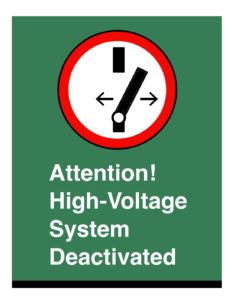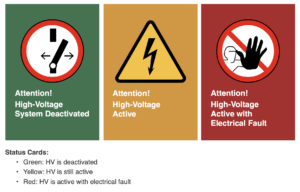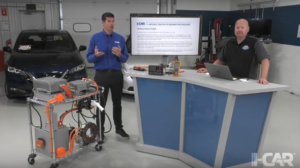
I-CAR offers best practice guide for disconnecting high-voltage EV batteries
By onAnnouncements | Education | Market Trends | Repair Operations | Technology
With the proliferation of EVs continuing, the Inter-Industry Conference on Auto Collision Repair (I-CAR) has developed a comprehensive best practice guide for a high-voltage disconnecting procedure to guide repairers safely through what can be a highly dangerous process, the organization announced.
Jeff Peevy, I-CAR Vice President, Technical Products, Programs & Services, explained that the new document is designed to complement OEM repair procedures, providing clear, safe guidance for technicians. I-CAR said the document is an inter-industry first.
“As EV repairs are becoming more commonplace, with more than 100 makes and models either in production or in various stages of development, I-CAR used OEM repair procedures to create a complementary document that guides a consistent disconnecting procedure process, in hopes to eliminate any confusion in what can be a dangerous repair process,” Peevy said.
“We’re bringing clarity and guidance to keep technicians safe and to minimize risks and errors for any technician, working on any EV vehicle, at any shop or location in the industry,” he said.
The material is available without charge. The documents within the best practice include:
- I-CAR Best Practice – HV Disconnecting Procedure, which is used to safely disable and test the vehicle.
- I-CAR Best Practice – HV Safety Protocol, which is a form that is used to document the inspections and tests.
- I-CAR Best Practice – HV Disconnecting Procedure Status Cards, which are printable and used to identify the current status of the HV vehicle.
 On its website, I-CAR stresses that its best practice is meant to complement OEM procedures, and “does not take the place of any OEM procedures, OEM requirements or contribute to any OEM specifications of skills, tooling, training or equipment enabling a repair facility to work on high-voltage (HV) vehicles.”
On its website, I-CAR stresses that its best practice is meant to complement OEM procedures, and “does not take the place of any OEM procedures, OEM requirements or contribute to any OEM specifications of skills, tooling, training or equipment enabling a repair facility to work on high-voltage (HV) vehicles.”
It also stresses that “only qualified high-voltage technicians with proper PPE [personal protective equipment] are permitted to work on the high-voltage system, carrying warnings that ignoring the recommended procedures and measures can lead to serious injuries and/or death.”
“Repair facilities should always reference the documented OEM procedures for the make, model, and year
of the vehicle before starting work to ensure a safe and proper repair,” I-CAR said.
According to Scott VanHulle, I-CAR Manager, Repairability Technical Support and OEM Technical Relations, the document is the result of collaboration among vehicle makers, collision repairers, insurers and tool and equipment manufacturers at an EV Technical Repair Summit held in May.
Peevy told RDN that the topic of the EV Technical Summit was “driven by consistent feedback from collision repairers, OEMs and insurers that steps to keep staff safe while working around electric vehicles were needed.”
He said I-CAR, led by Dirk Fuchs, I-CAR Director of Technical Programs and Services, collected the information that was discussed during the summit and through participant responses identified these steps that resulted in the published best practices.
“With electric vehicles, we are very aware of the knowledge gap that exists, and we want to help close that gap,” Peevy said. He also stressed that in no way do these best practices supersede OEM repair procedures or technical bulletins.
“This is just a good example of I-CAR doing what it can to educate the industry. We’ll continue to do more and more research around the new technologies, and provide as much insight and information as possible,” he said.
Fuchs underscored that the document “is available to everyone in the industry…. We want to keep collision repair staff safe and minimize risks and mistakes.”
The recommended procedure is modeled after the European regulation ECE-R-100 to ensure that a collision-damaged vehicle is safe, as there is a higher level of possible damage to the high-voltage (HV) safety systems, I-CAR said.
The European regulation defines “high voltage” as a working voltage of between 60 and 1,500 volts DC, or 30 and 1,000 volts AC.
Makers of EVs have highlighted the danger that the higher current presents to repairers, and taken steps. Audi, which produces the E-Tron Sportback, stipulates that all employees at its dealerships and certified auto body shops must be “High-Voltage Aware,” a minimal level of training that includes customer awareness.
According to Audi collision program manager Mark Allen, some staff at the facilities have been trained as High-Voltage Technicians, educated about concepts like battery theory, diagnosis, de-energization and re-energization. For any work that’s more extensive, a High Voltage Expert is required. Those technicians are able to disassemble, repair, and reinstall batteries.
“We are very good conductors of electricity,” Allen said In a virtual OEM Collision Repairer Technology Summit session released in November 2020, while displaying a slide of the human body’s electrical resistance. He said the iron in human blood “just loves to transfer electricity,” which can produce “disastrous consequences.”
Included in the I-CAR procedures are comprehensive instructions for initializing an EV after repairs are complete.
“Technology continues to redefine the future of collision repair, and this is another way I-CAR is helping lead the industry forward with responsible, relevant and robust solutions that advance our vision and mission,” Peevy said.
I-CAR has anticipated the coming wave of EVs, and has been taking steps to respond to the needs of the inter-industry. In June, it announced the creation of “CHARGED for EV,” an (EV) resource to provide the inter-industry with a centralized information hub in support of the ongoing acceleration of EVs and their impact on the collision repair industry.
The no-fee resource, i-car.com/electric-vehicles, features news and information relevant to EV training, EV definitions, I-CAR EV course information and the latest EV topics and trends, including insights from EV Subject Matter Experts within I-CAR and the Inter-Industry. Seven free training courses related to EVs are available at the site.
On Aug. 26, I-CAR announced that it will open a second technical center in the Chicago area for advanced research and development on EV and other technologies, in order to continue delivering needed education and support for the collision repair inter-industry.
I-CAR said the addition of the second technical center is key to its efforts to expand its technical expertise, capacity and capabilities as automotive technologies continue to evolve. The new center will focus on ongoing and emerging technology complexities associated with Electric Vehicles (EVs), Hybrid Vehicles (HV), Advanced Driver Assisted Systems (ADAS) and more, I-CAR said.
The new site, the location of which has not yet been announced, will augment I-CAR’s existing technical center in Appleton, Wisc. It is expected to be in operation by the first quarter of 2022.
Although EVs represent less than 1% of the vehicles on U.S. roads today, their numbers are certain to rise as costs of battery production fall and public charging stations continue to be built. Earlier this week, at the International Motor Show IAA MOBILITY 2021 in Munich, Volkswagen presented its ID.LIFE concept car, an affordable EV that would sell for 20,000 euros, or about $26,000.
President Joe Biden on Aug. 5 signed an executive order setting a new target to make half of all new vehicles sold in 2030 zero-emissions vehicles, including battery electric, plug-in hybrid electric, or fuel cell electric vehicles, as well as announcing that the United States would invest in the first-ever national network of electric vehicle charging stations.
The Big Three automakers issued a joint statement in support of the president’s plan, underscoring their commitment to increasing production of low emission vehicles.
More information:
I-CAR: ‘Bonding is your lifesaver’ on electric vehicles
I-CAR launches “Charged for EV”; new online electric vehicle resource library for industry
A list of EVs currently sold in the U.S.
https://www.cnet.com/roadshow/news/electric-car-ev-range/
Images:
Lead image: I-CAR HV Disconnecting Procedure Status Card (I-CAR)
Dick Fuchs, left, I-CAR Director of Technical Programs and Services, and Scott VanHulle, I-CAR Manager, Repairability Technical Support and OEM Technical Relations, present during I-CAR’s EV summit. (YouTube screen capture)

